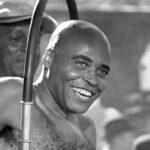Queens of the Court: Monica Seles, What If?
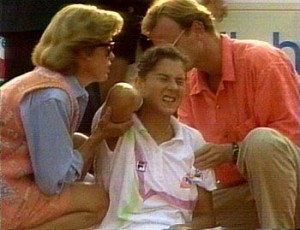
It is hard not to wonder just how great Monica Seles could have been were it not for the attack in Hamburg.
Monica Seles, a former world No. 1 tennis player, released her memoir Getting A Grip: On My Body, My Mind, My Self on April 21, 2009.
The autobiography details her bout with depression and her subsequent food addiction after being stabbed in a tennis tournament in Germany.
It also describes dealing with her father’s cancer diagnosis and eventual death, which devastated a daughter who was very close to her dad. Finally it follows her journey back to the game and her aim for a life beyond tennis.
Later on July 11, 2009, Seles was inducted into the International Tennis Hall of Fame, drawing attention to her story by a generation of tennis fans who may have missed her extraordinary rise to the top of the women’s game in the ’90s.
The Early Years
Monica Seles was born in Novi Sad, Yugoslavia on Dec. 2, 1973 but she became a naturalized citizen of the United States in 1994. She started playing tennis when she was five years of age.
Her father, Karoly Seles, coached her and was the one who helped her develop her unique two-handed style with both the forehand and the backhand. He also contrived special moments that made the day-to-day practices fun for the little girl.
She was one of many tennis talents discovered and developed by Nick Bollettieri, training in the Bollettieri Tennis Academy for two years.
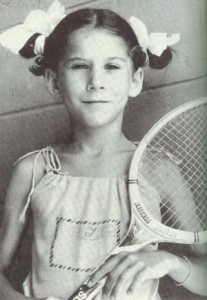
Seles was a tennis phenom from an early age.
When she burst onto the tennis scene in 1990, Seles added something exciting to the women’s game. Along with her youthful exuberance, she brought bold enthusiasm and joy.
Prior to Seles’ arrival it was rare to watch a match on the women’s tour and see anyone who looked happy and alive. Most professionals of the day were grim and determined on court. By the looks on their faces, you were left with the impression that they were pile-driving stakes into the ground rather than playing a game.
Seles eradicated the stern headmistress countenance from the women’s game.
Granted, in tennis it is necessary to ingrain single-minded concentration as part of winning. Seles did that as well as bringing fire, deceptive speed, and power along with extreme angles to the tennis court and astonishingly, all could see she was having fun out there.
This was, after all, the era of Steffi Graf, the iron maiden of the tennis elite. Steffi executed her game and her opponents with scalpel-like efficiency. There seemed to be no joy in Tennisville when Graf donned her tennis whites.
What is more—the perky little Yugoslavian was noisy. Monica Seles introduced the grunt into the dainty game of women’s tennis. Thus, fans and the media began the endless debate descrying the habit and the noise emanating from the upstart.
Seles took the ball early—extremely early and she blasted it with her two-handed strokes on either side. She pushed the boundaries of tennis forward and sped through her matches playing a different brand of tennis than anyone else on tour.
In 1988, Seles played her first professional tournament at the age of 14. She finished her first year on tour world ranked at No. 6 after reaching the French Open semifinal where she lost to then-world No. 1 Steffi Graf 6-3, 3-6, 6-3.
At the tender age of 16, Seles won her first Grand Slam Championship in 1990. She became the youngest champion in the history of the French Open. Facing Steffi Graf in the final, Seles managed to fight off four set points before she took the opening set tiebreaker 8-6. Seles ended up winning the final in straight sets 7-6, 6-4.
She ended 1990 ranked No. 2 after defeating Gabriella Sabatini in five sets at the year-end championships.
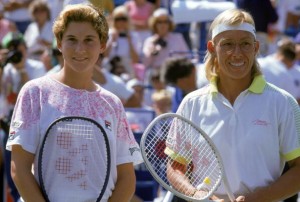
Seles defeated Martina Navratilova to win the 1991 U.S. Open.
Seles went on to dominate the women’s tour in 1991-92. In 1991, she won three of the four Grand Slams, electing not to play at Wimbledon because of continuing problems with shin splints.
She succeeded Graf at the No. 1 ranking in March of 1991, finishing the year by winning the year-end championships—defeating Martina Navratilova in four sets.
In 1992, she repeated her three wins in slam finals. At Wimbledon, she defeated Navratilova in the semifinals but lost to Graf in the finals 6-2, 6-1. Both Navratilova and Graf officially complained about the Seles grunting.
The Stabbing Incident
Keep in mind that this tennis phenom was still a teenager with teenage dreams, aspirations, and outlooks. Her talent was phenomenal and her energy level never dipped. She loved the spotlight and like teenagers everywhere, delighted in re-inventing herself. She had many fans and just as many detractors.
Regardless, when Monica Seles took the court, there was nothing less than her best on display at all times. Whether she won or she lost, Seles was a fighter to the end and a gracious opponent regardless of the outcome.
She began 1993 by winning the Australian Open for the third consecutive year. She was 19 years of age and just heading into the years of peak physical strength.
Later that year, an incident on court changed her life and forever altered the career of what may well have been the best female tennis player in the history of the women’s game.
While playing in the Hamburg quarterfinals in April of 1993, an obsessed German fan of Steffi Graf’s stabbed Seles in the back with a boning knife. Gunter Parche was later pronounced “crazy” after being arrested. He was never tried for his crime.
Seles, who recovered quickly from her physical wounds, was unable to compete for over two years. When she did return to the court, her abilities were never the same. Her career was cut short by a mad man—while we all sat and watched in stunned horror.
The stabbing temporarily impaired her physically, but the real damage came to her psyche. She was never the same player when she returned to action in 1995. Some of the fire and the unshakable confidence had been stripped from her game. Her consistency was gone and her spirit dampened.
She remained an excellent player but never achieved the No. 1 pinnacle again.
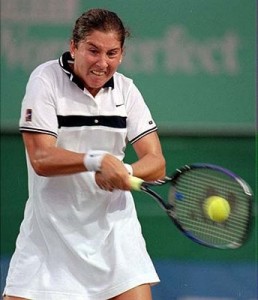
Seles won nine Grand Slam singles titles, but the 1996 Australian Open was the only one she won following the stabbing incident.
Seles did win another Australian Open title in 1996, defeating Anke Huber in the final. She appeared in three more grand slam finals prior to 1998.
In 1995, she met Steffi Graf in the final of the U.S. Open, losing 6-7, 6-0, 3-6. She lost to Graf again in the 1996 U.S. Open 7-5, 6-4 and in 1998 she lost to Arantxa Sanchez Vicario at the French Open 7-6, 0-6, 6-2.
Seles accumulated nine Grand Slam Championships, winning on every surface except the green lawns of Wimbledon. She was listed as the 13th greatest player of all time by US Tennis magazine. She was also one of 15 women named by Australian Tennis magazine as the greatest champions of the last 30 years.
She never played again after 2003. The desire to return to the game never deserted her but the will never succeeded. Monica Seles was inducted into the Tennis Hall of Fame in 2009. Her legacy remains intact. It is career to be proud of.
But you must wonder what was lost when a madman attacked her without provocation, driving a knife into her back and pronouncing a death sentence on her brilliant career.
This is the last in our series of great women tennis players who helped to shape the game today. We will be detailing the contributions of the great male tennis players in our next outing.
Read our other articles in this series about great women players and their contribution to tennis:







